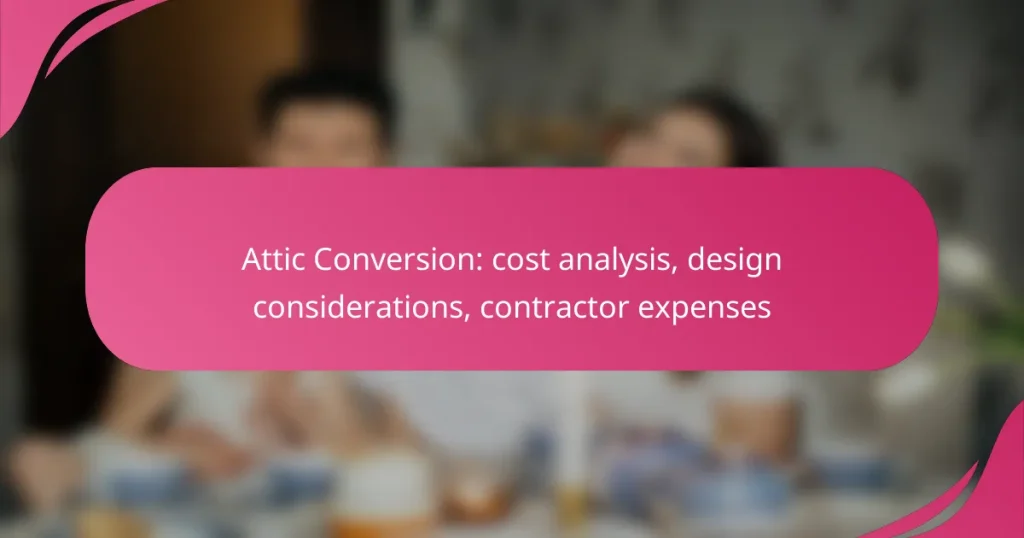Converting an attic into a functional living space can be a rewarding investment, with costs in Canada typically ranging from CAD 20,000 to CAD 50,000. Key design considerations such as maximizing space, ensuring compliance with building regulations, and providing adequate insulation and ventilation are essential for a successful outcome. Choosing an experienced contractor who is familiar with local codes will help ensure quality workmanship and adherence to your budget.

What is the average cost of an attic conversion in Canada?
The average cost of an attic conversion in Canada typically ranges from CAD 20,000 to CAD 50,000. This price can vary based on factors such as the size of the attic, the complexity of the design, and the materials used.
Typical cost range
For most homeowners, the cost of converting an attic falls between CAD 20,000 and CAD 50,000. Basic conversions that involve minimal structural changes may be on the lower end, while more elaborate designs with custom features can push costs higher. It’s essential to budget for both construction and finishing costs, which can significantly impact the overall price.
Factors affecting cost
Local building codes and regulations may also affect costs. Obtaining necessary permits and ensuring compliance with safety standards can add to the overall budget. Finally, the choice of contractor and their experience level can lead to variations in pricing.
Regional cost variations
Costs for attic conversions can vary significantly across Canada. In major urban centers like Toronto and Vancouver, prices tend to be higher due to increased demand and labor costs. Conversely, smaller cities or rural areas may offer more affordable options.
It’s advisable to research local market conditions and obtain multiple quotes from contractors in your region. This will help ensure you receive a fair price and understand the typical costs associated with attic conversions in your area.

What design considerations are important for attic conversions?
When planning an attic conversion, key design considerations include maximizing space, adhering to building regulations, and ensuring proper insulation and ventilation. These factors significantly influence the functionality, safety, and comfort of the newly created living area.
Space utilization
Effective space utilization is crucial in attic conversions to create a functional living area. Consider the layout carefully to maximize usable space while accommodating necessary features like stairs and windows. Open floor plans can enhance the perception of space, while built-in storage solutions can help manage clutter.
Additionally, think about the purpose of the converted attic. Whether it’s a bedroom, office, or playroom, tailor the design to meet specific needs, ensuring that furniture and fixtures fit well within the available dimensions.
Building regulations
Building regulations play a vital role in attic conversions, as they dictate safety standards and structural integrity. Before starting, check local regulations regarding ceiling height, fire safety, and egress requirements. In many areas, a minimum ceiling height of around 2.4 meters is required for habitable spaces.
Obtaining the necessary permits is essential; failure to comply can result in costly fines or the need to undo work. Consult with local authorities or a professional contractor to ensure all regulations are met before proceeding.
Insulation and ventilation
Proper insulation and ventilation are critical for maintaining a comfortable environment in an attic conversion. Insulation helps regulate temperature, keeping the space warm in winter and cool in summer. Aim for insulation with a thermal resistance (R-value) suitable for your climate, typically ranging from R-30 to R-60.
Ventilation is equally important to prevent moisture buildup, which can lead to mold and structural damage. Install vents or windows to promote airflow, and consider using exhaust fans in areas prone to humidity, such as bathrooms. Balancing insulation and ventilation will enhance energy efficiency and comfort in the converted attic.

How to choose the right contractor for an attic conversion?
Selecting the right contractor for an attic conversion is crucial for ensuring a successful project. Look for experienced professionals who understand local building codes and can deliver quality workmanship within your budget.
Key qualifications to look for
When evaluating contractors for your attic conversion, prioritize those with a solid track record in similar projects. Verify their licenses, insurance, and any relevant certifications that demonstrate their expertise in construction and design.
Experience in attic conversions specifically is essential, as these projects often involve unique structural challenges. Ask for references and examples of previous work to assess their capability and style.
Questions to ask potential contractors
Prepare a list of questions to gauge a contractor’s suitability. Inquire about their experience with attic conversions, including the number of projects completed and any challenges faced. This will help you understand their problem-solving abilities.
Additionally, ask about their timeline for completion, payment structure, and how they handle unexpected issues. Clear communication is vital, so ensure they are responsive and willing to discuss your vision in detail.
Contractor cost estimates
Cost estimates for attic conversions can vary significantly based on factors such as location, size, and complexity of the project. Generally, you might expect costs to range from several thousand to tens of thousands of dollars, depending on the scope of work.
Request detailed estimates from multiple contractors to compare pricing and included services. Be wary of unusually low bids, as they may indicate subpar quality or hidden costs. Ensure that each estimate outlines labor, materials, and any additional fees to avoid surprises later on.

What are common challenges in attic conversions?
Attic conversions often face several challenges that can complicate the process and increase costs. Understanding these issues can help homeowners plan effectively and avoid unexpected hurdles.
Structural limitations
Structural limitations are a primary concern in attic conversions. Many attics have low ceilings, inadequate support beams, or insufficient space for stairs, which can restrict design options. Homeowners should assess the existing structure to determine if reinforcement or modifications are necessary.
In some cases, it may be essential to consult a structural engineer to ensure that the attic can safely support additional weight from living spaces. This assessment can help identify potential issues early in the planning stage.
Permitting issues
Permitting issues can significantly delay an attic conversion project. Local building codes often require permits for structural changes, electrical work, and plumbing installations. Homeowners should check with their local authorities to understand the specific requirements and timelines for obtaining necessary permits.
Failure to secure the appropriate permits can lead to fines or the need to undo completed work, resulting in additional costs and time lost. It’s advisable to factor in permitting time when planning the overall project timeline.
Budget overruns
Budget overruns are a common challenge in attic conversions due to unforeseen expenses. Costs can escalate from structural modifications, permit fees, and unexpected repairs. Homeowners should prepare a detailed budget that includes a contingency fund of around 10-20% to cover these potential extras.
To avoid budget overruns, it’s crucial to obtain multiple quotes from contractors and clearly outline the scope of work. Regularly reviewing expenses against the budget throughout the project can help keep spending in check.

What are the benefits of converting an attic?
Converting an attic can significantly enhance your home’s functionality and value. This process transforms unused space into a practical area, offering various advantages such as increased living space, improved property value, and enhanced energy efficiency.
Increased living space
Converting an attic provides additional living space that can be used for various purposes, such as a bedroom, office, or playroom. This is particularly beneficial for growing families or those needing a dedicated workspace at home.
When planning an attic conversion, consider the layout and how to maximize the usable area. Ensure that the design allows for adequate headroom and natural light, which can make the space feel more inviting.
Increased property value
Adding an attic conversion can significantly boost your property’s market value. Homebuyers often look for additional living space, and a well-executed attic conversion can make your home more attractive in a competitive market.
Research indicates that homeowners can expect a return on investment (ROI) ranging from 60% to 80% for attic conversions, depending on the quality of the work and local market conditions. It’s wise to consult with real estate professionals to understand how much value a conversion may add in your area.
Energy efficiency improvements
Converting an attic can lead to better energy efficiency, especially if insulation and ventilation are addressed during the process. Proper insulation can help regulate temperatures, reducing heating and cooling costs.
Consider installing energy-efficient windows and using sustainable materials to enhance the overall energy performance of the space. These improvements not only lower utility bills but can also contribute to a more comfortable living environment.

What are the steps involved in an attic conversion?
An attic conversion involves several key steps, including initial assessment, design planning, obtaining necessary permits, and hiring contractors. Each step is crucial for ensuring a successful transformation of the attic space into a functional area.
Initial assessment
The initial assessment is the first step in an attic conversion, where you evaluate the existing space and its potential. Check for structural integrity, insulation quality, and headroom, as these factors will influence the feasibility and cost of the project.
Consider the layout and how the attic can best serve your needs, whether as a bedroom, office, or playroom. It’s advisable to take measurements and note any existing features like windows or chimneys that may affect design options.
Engaging a professional for this assessment can provide insights into necessary reinforcements and compliance with local building codes, which may vary by region. This step is essential to avoid costly surprises later in the conversion process.

